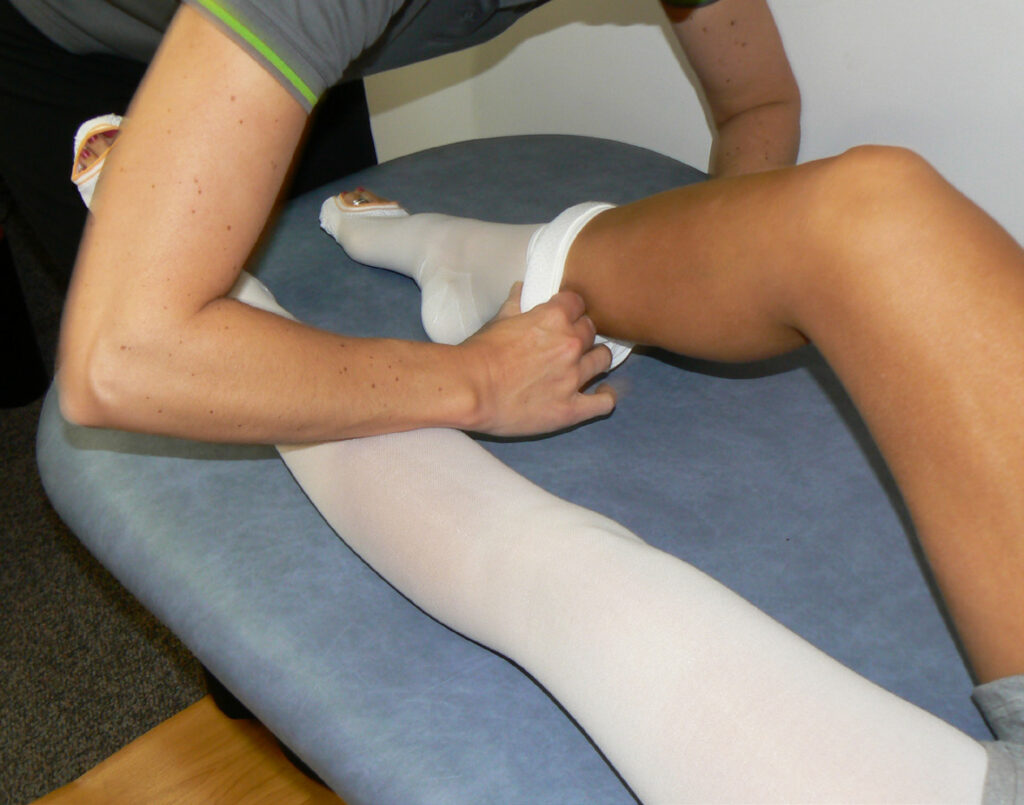Compression Stockings – A Guide for Patients
INTRODUCTION |
||
|
You have been fitted with a pair of graduated compression stockings. Compression stockings provide support and aid in venous (blood) return. The stockings are graduated to move fluid only toward the heart. The stockings compensate for the inefficiency of your veins or lymphatic system in moving fluid and blood back to your heart. Compression stockings come in various compression ratings and styles to cope with different conditions and severity. Your Orthotist will have measured you and fitted you with the correct size and style according to your specific requirements. |
 |
APPLICATION
Stockings should be fitted first thing in the morning and removed before going to bed at night.
There are several ways to put stockings on and your orthotist will show you the best way for you.
Opposite is the most common method:
FITTING
This process may be made easier by;
Placing a plastic bag over your foot before pulling the stocking on (this is only possible for open toe garments). Wearing rubber gloves (used for washing dishes) to help you grip the stocking.
• For moist skin use talcum powder to help the stocking glide over the skin.
• Ask for assistance from a relative or a friend!
Also available are silky slips (instead of plastic bags) and special frames to aid in putting stockings on. Your orthotist will suggest these options should you require them.
REMOVAL
The easiest method of removing a stocking is to do the reverse of the way that you put it on. Many people have trouble moving the stocking past their heel, as this is the tightest section, but pushing your thumb down the back of your heel and easing it over your heel will make it easier.
GENERAL CARE
Stockings are best washed by hand in warm water with mild soap (eg wool wash) and rinsed in clear cold water. Do not use bleach. Roll stocking into a towel and gently squeeze excess water out. Dry in the shade or indoors. Avoid sunlight or direct heat. The stockings must not be ironed or tumble dried. Do not hang stocking from toe or top as it may stretch, instead lie it flat on a dry towel.
Stockings are best washed each evening before bed and should dry by morning. However it is recommended to have a spare stocking to wear on alternate days.
Although stockings are quite strong be careful of sharp finger nails and rings! To avoid damaging the stocking use rubber gloves when putting the stocking on.
Stockings should always be worn with shoes to protect the stocking and prevent you from slipping.
To increase durability, socks can be worn over the top of the stockings.
Ensure that footwear is in good condition on the inside since a defect in the shoe lining may in crease friction and quickly lead to damage of your stocking.
Please DO NOT repair the stocking yourself. If a defect occurs contact your orthotist.
Over time stockings begin to stretch and will no longer provide adequate support. At this time they will probably need replacing.
We usually recommend that patients be remeasured for subsequent / replacement pairs of stockings as your legs may have less swelling or sizing may have changed.
Compression stockings should only be worn after consultation with your doctor. If any of the following signs appear remove the stocking immediately and contact your orthotist:
• Swelling of the toes or above where the stocking finishes.
• “Blue” toes
• Change in sensation in your foot (ie tingling, numbness)
• Pain
• Laddering of the fabric (in new stocking)